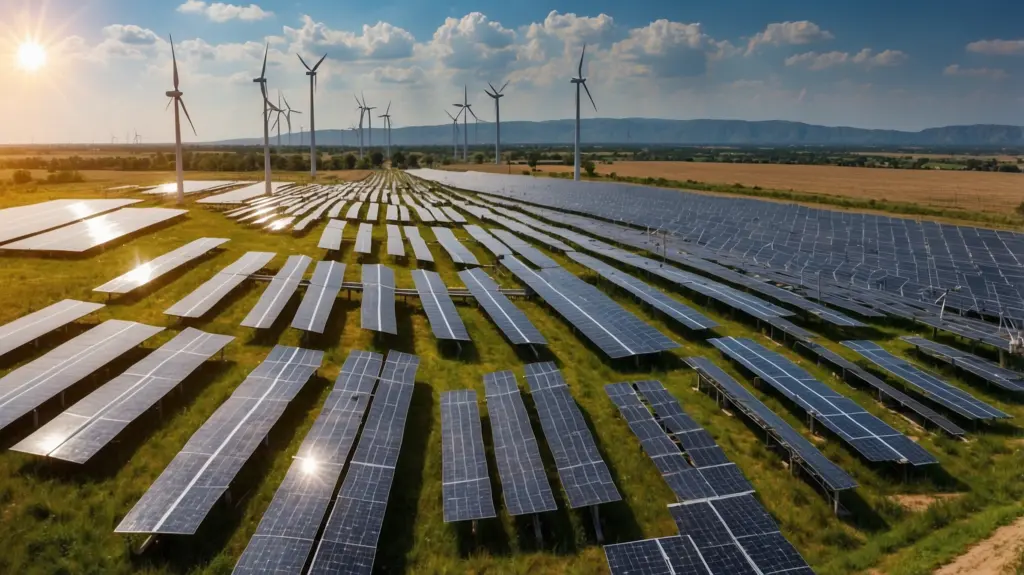GLOBAL WARMING AND ITS PREVENTION WITH RENEWABLE ENERGY
Global warming refers to the long-term increase in Earth’s temperature due to human activities. It usually happens due to the burning of fossil fuels like coal, oil, and natural gas, which are used in most industrial processes. These activities lead to the high emission of greenhouse gases like methane (CH4), carbon dioxide (CO2), and nitrogen oxide (N2O) in the atmosphere.
Greenhouse gases are used to trap heat in the atmosphere, causing changes in the environment and Earth’s climate repeatedly. While looking after global warming, it requires a lot of effort to reduce the emission of greenhouse gases, renew natural energy resources, improve energy efficiency, and protect the ecosystem.

EFFECTS OF GLOBAL WARMING:
1. Rising sea level due to the high melting of polar ice and glaciers.
2. Severe weather calamities like hurricanes, cyclones, and heatwaves.
3. Disturbances in ecosystems create impacts on agriculture, water resources, and oxygen levels.
4. Shifts in weather patterns also lead to floods and droughts.
ADVANTAGES OF RENEWING ENERGY
BRIEF OVERVIEW OF RENEWING ENERGY RESOURCES AND THEIR IMPORTANCE IN THE GLOBAL ENERGY LANDSCAPE.
- Reduce greenhouse gas emissions: renewing energy resources like solar, wind, and hydroelectric power results in zero greenhouse gas emissions, helping to change the climate and reduce air pollution.
- Environmental Benefits: Renewable energy production has a lower impact on the environment than fossil fuel extraction. It reduces water consumption and protects ecosystems associated with mining and drilling activities.
- Human Health: Renewable energy helps to improve human health outcomes by reducing respiratory illnesses, cardiovascular diseases, and other health problems caused by air and water pollution.
- Long-Term Sustainability: Renewable energy sources are sustainable and offer a long-term solution to meet basic energy needs while reducing environmental degradation and preserving natural resources for future generations.
DIFFERENT TYPES OF RENEWABLE ENERGY
- Solar Energy
- Wind Energy
- Hydro Energy
- Biomass or Geothermal Energy
MAJOR USES OF RENEWABLE ENERGY OR PREVENTION OF GLOBAL WARMING
Renewable sources of energy like solar, wind, hydro and biomass energy can be an alternative option for not using fossil fuels. It can also help prevent global warming on our planet.

global-warming-and-its-prevention-with-renewable-energy
Here are some ways to renew natural energy for future uses and stop global warming:
Solar energy: Solar energy can be obtained from sunlight, which is one of the fastest-growing renewable energies. Photovoltaic (PV) panels are used for converting sunlight directly into electricity. Solar energy has a wide role for reducing carbon emissions, mainly in regions with extensive sunlight.
Wind power: Wind energy is generated by using the kinetic energy of wind, which is another crucial form of renewal energy. Wind energy is converted into electricity using wind turbines. By utilizing wind energy, the reduction of carbon dioxide emissions (CO2) can happen widely.
Hydro-power energy: Hydro-power energy can be generated by capturing the flow of running water, which is one of the most widely used renewal energies. Hydroelectric dams and running water in rivers help to produce electricity by utilizing the gravitational force of falling water to run turbines. That’s why it also plays a role in reducing carbon emissions.
Geothermal energy: Biomass or geothermal energy can be obtained from organic materials like wood and biodegradable waste, which can be used for generating heat, electricity, and biofuels. Geothermal energy also provides a reliable and continuous source of power, reducing greenhouse gas emissions.

CONCLUSION
Renewable energy holds immense promise for reducing global warming by reducing greenhouse gases that emit and transit from fossil fuels. Its capacity to reduce greenhouse gas emissions by producing solar, wind, hydro, and geothermal energy can create a more sustainable ecosystem by safeguarding the health of future generations on our planet.
We can reduce climate change, protect our planet, and create a more sustainable world for our generations to come. Embracing renewable energy is not only an option for a better environment; it can also be a safeguard for our planet’s health and well-being.
CHECK OUT:
-
Understanding the Importance of Water in India’s Future
-
Exploring Amazon Rainforest: Amazing Facts you didn’t know about this biodiversity -
Unravelling the mysteries of Bermuda Triangle








0 Comments